We report the two special lectures on geotechnical topics presented in the first FORUM8 design conference in Tokyo Conference Center Shinagawa, September 9 in 2007.
This conference is aimed to openly present and discuss the design, analysis and CAD solutions of FORUM8 in associating with the fifth UC-win/FRAME(3D) workshop.
The First FORUM8 Design Conference
- UC-win/UC-1 User Conference Program Introduction Page
- Conference Overview
- Seminar Report
| Special Lecture on Geotechnical Analysis Software Series, "Actual condition and issue of Geotechnical Analysis" |
| Keizou Ugai (Doctor of Engineering) | |
| Major: | Geotechnical Engineering |
| Personal history: | aster of Science and Engineering from Tokyo Institute of Technology. Research Assistant of Civil Engineering Division, Department of Engineering at Niigata University. Assistant Professor of Construction Engineering Division, Department of Engineering at Gunma University. At present, Professor of Geotechnical Engineering Research Laboratory, Department of Civil and Environmental Engineering, Chief of Kantou Branch of Japan Landslide Society |
| Awards: | Contribution prize of the Japan Geotechnical Society in 1999 Excellent paper prize of the Japan Landslide Society in 2003 |
| Professor Ugai is an expert of landslides and specially concentrates research on landslides during earthquakes at present. The 2004 Niigata-ken Chuuetsu Earthquake motivated his research. He started to survey the disasters, for many tremendous landslides occurred in the mountainous area. Since then, he found the mechanism of slope failures during earthquakes. He has a plan to systemize his findings and to fully present the details in future. He is also engaged with FORUM8 as an advisor to review our programs in our Geotechnical Analysis Software Series. In this time, he talked about "Using FEM in seepage analysis", "Damages by liquefaction and measures", "Recent topic on earthquake disaster", and "Recent trend and problems of Geotechnical Analysis" with many applied examples. s for "Using FEM in seepage analysis", he mentioned the verification results and necessity of 3D analysis after compared with the theoretical solution and the results of 2D analysis. He presented the effectiveness in drainage performance of well points and bore halls evaluated using 3D analysis. In the presentation of "Damages by liquefaction and measures", he introduced some examples of damages by liquefaction occurred in the 1964 Niigata earthquake and the 2004 Niigata-ken Chuuetsu earthquake. He mentioned the necessity to simulate liquefaction phenomena using FEM analysis (fig.2) and to conduct performance design because of the significant influence of liquefaction on infra-structure. As recent topics, he presented "Analysis example of rock slope failed during the 2004 Niigata-ken Chuuetu earthquake", "Deformations and damages in residential land by liquefaction occurred in the 2007 Chuuetsu-oki earthquake". In the former topic, he mentioned the landslide mechanism due to the rapid degradation in soil strength during cyclic shear deformations (fig.3).In the latter topic, he talked about the necessity to use UWLC as dynamic analysis software for quantitatively evaluating the safety improvement of residential land by soil improvement and reinforcement in future. Finally, as the problems and visions in utilizing FEM for geotechnical analysis, he gave us two advices; (1) Use FEM in performance design, (2) Improve convinience of FEM software. In his opinion, FEM will be essential for performance design which will be a major design method. To meet this requirement, he advised that it was very important for FORUM8 to take in consideration of the needs and convenience of users while developing FEM software. |
|
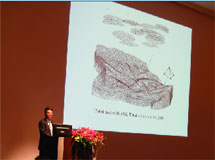 |
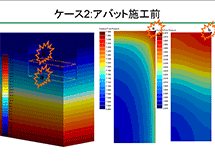 |
|
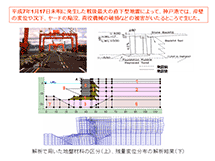 |
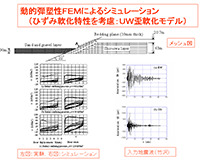 |
|
- 3D elasto-plastic finite element analysis of soil, Maruzen, 1996
- Guide to understand elasto-plastic finite element anlysis, The Japana Geotechnical Society, 2003
| User's special lecture on Road Work Design "Example of slope stability calculation and future issue" |
| Cai Fei (Doctor of Engineering) | |
| Major: | Geotechnical Engineering |
| Personal history: | Master of Engineering from Tsinghua University. Researcher in the water resource in water resources laboratory, the Ministry of water, traffic, and electric power industry. Research Assistant of Civil Engineering Division, Department of Engineering at Gunma University. At present, Assistant Professor of Construction Engineering Division, Department of Engineering at Gunma University |
| Awards: | Prize of the best paper in the third international conference on landslides and safety of social infra-structure (Singapore) in 2002, Prize of the best presentation in the international symposium on subsurface water problems in ground environments, IS-OKAYAMA, Prize of research encouragement in 2004, the Japan Landslide Society |
| Assistant Professor Cai is engaged with the researches, such as landslide
measures, liquefaction, seepage analysis, etc. through numerical analysis
of soil. Professor Ugai and Assistant Professor Can, and also Associated
Professor Wakai lead the geotechnical laboratory, studying on geotechnical
analysis with mostly regarding to the elasto-plastic and non-linear problems
of soil by FEM. He developed the most of solvers as engines for UWLC, GeoFEAS,
VGFlow, LEM3D which consist of Geotechnical Engineering Software Series. In this time, as examples of important slope stability analysis and problems in future, he gave us a lecture on "Definition of factor of safety", "New back analysis", "Evaluation of total stability of residential land embankment" and "Problems in future". As the definition of factor of safety, he mentioned factor of safety based on two kinds of definition; "Ratio of sliding force on a failure surface and shear resistance" and "Reduction factor of shear resistant constants to create the equilibrium state in a slope along a failure surface" and the method for calculating necessary resistant forces. He also explained the differences in the two kinds of definition (fig.1). For the new back analysis, he explained "experiential method", "Yamagami and Ueda's method" and "Saitou's method", and in addition he introduced the concept of the new back analysis and some verification examples through case study. As for the evaluation of total stability of residential land embankment, he notified that a more dangerous failure surface than an arc failure surface would be possibly created, using key words, stability of embankment slope, total stability of embankment, filling valley type, and lateral filling type (fig.2) from the commentary on the guideline of deformation prediction survey in large residential land embankment. As problems in future, he suggested (1) method of automatic searching a critical failure surface, (2) method to calculate factor of safety by the limit equilibrium state method in accordance with the standard or design guideline with regards to the failure critical surface, which is found as a critical failure surface by the shear resistance reduction FEM (SSR-FEM) (fig.3). (3) new method to divide a slope into slices, uniform central angle method, to avoid some errors due to the number of division in the uniform width method used generally, and (4) needs to use 3D slope stability analysis. We recognized some dwelling problems in arc slope stability analysis which was assumed to have no argument about the basic idea as an evaluation method, and resolved to work for a new design method. |
|
 |
 |
|
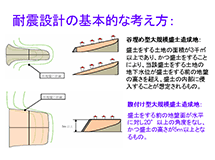 |
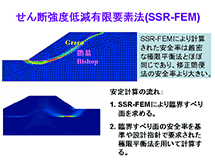 |
|
-Ukai,K.Wakai,A and CAI FEI:Introduction to Slope Stability/Deformation Analysis, Japanese Geotechnical Society, 2006
-Ukai,K.Wakai,A and CAI FEI:Landslide Analysis with Finite Element Method, Sankaido, 2006

